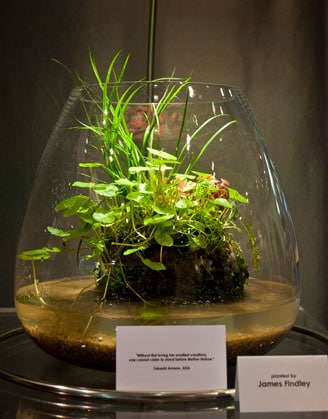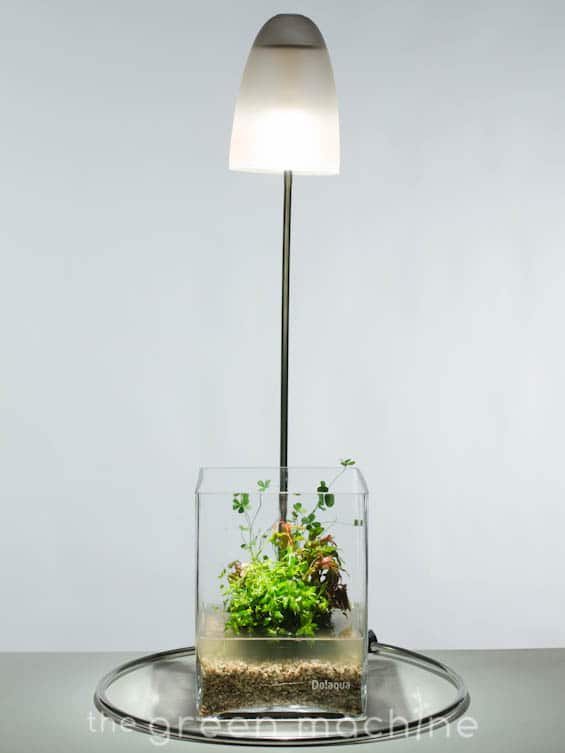
Read on to learn about the origins of Wabi-kusa and then click on the video link at the bottom of the page, or go straight to the Wabi-kusa video tutorial by James Findley by clicking here.
This month we check out the very latest concept to hit the aquascaping market; Wabi-kusa.
Like any true art form, aquascaping has continued to evolve and develop with every new generation that indulges in it. Once aquascapers had mastered the art of creating living underwater gardens they wanted a new challenge. This, coupled with the ever growing, globalising population of the planet and the increasing scarcity of space naturally led the pioneers of aquascaping, like Takashi Amano, to explore a new concept; miniature aquascapes.

These miniature aquascapes provided a new challenge, desperately coveted by aquacapers and allowed even the most space-challenged households to indulge themselves in an aquascape and benefit from the many benefits of aquascapes; natural beauty, increased relaxation, reduced stress levels and a sense of artistic creation combined with a sense of natural science and evolution. These miniature worlds came to be known as ‘Nano’ aquascapes, and were closely followed by even smaller versions dubbed ‘Pico’ aquascapes.
The very latest, cutting edge wave of creation has been heralded by Takashi Amano and ADA of Japan who have introduced ‘Wabi-kusa’. This is a brand new and very exciting concept straight from Japan.
Check out our new Wabi-Kusa shopping section »
Definition
There is no literal translation of ‘Wabi-kusa’ in the English language. ‘Wabi’ denotes something aesthetic, imperfectly beautiful and natural (like in wabi-sabi). ‘Kusa’ means ‘grass’ or sometimes ‘plant’. Therefore ‘Wabi-kusa’ cannot be translated literally. It denotes something natural, beautiful, sweetly imperfect and involving plants. The English language is clearly not conceptual enough to have evolved a single word to express all those connotations, which is probably why we have kept the name ‘Wabi-kusa’; to maintain the simple elegance of the concepts the Japanese name denotes.
What are ‘Wabi-kusa’?
Wabi-kusa are balls of substrate that are covered with plants that are grown in their terrestrial form, very similar to plants that are grown hydroponically in nurseries. These substrate balls are placed directly into a small glass container with some water in and then allowed to grow naturally. You can buy a TGM Substrate Ball here.
This is a very different approach to aquascaping techniques, where the layout of the aquarium is planned with exquisite care and the plants are carefully maintained. Wabi-kusa allow nature to flow freely, and as such they produce stunning results. Wabi-kusa is a celebration of the wildness and chaos of nature, and as such it is extremely seductive and inspiring – a piece of wilderness in your home, bedroom or office. The compulsive power of Wabi-kusa is undeniable.
Once the Wabi-kusa is placed in the Plant Glass container a few inches of water are added, depending on the plants and the shape of container you have. Once this is done, simply place the Wabi-kusa under a suitable light for plant growth, like the Do!aqua Branch Light. Then sit back and witness the simple beauty of nature’s chaotic complexity. It is important to make sure that the light is suitable for plant growth – any specialist retailer should be able to advise you on this.
Unlike aquascapes, Wabi-kusa tend not to use hardscape (rocks and wood), although they can be added if desired. The idea is just to let nature flow, rather than staging it. It has to be said that given the controlling nature of aquascaping there is something daringly seductive about Wabi-kusa.

Conclusion
Wabi-kusa are chaotic, beautiful and dangerously seductive, even for the most meticulous of aquascapers. They have a strange allure – a strong attraction to their chaotic simplicity that flies in the face of the forethought and planning that mainstream aquascaping demands. Wabi-kusa question our ideas and approach, they stand up to pre-conceived ideas and challenge our rules. And they succeed. They are beautiful, idyllic and captivating. Wabi-kusa questions all the rules and succeeds in the strongest way; by making us want it. Their magnetism is undeniable, unshakeable and enthralling. Aquascapers all over the world have been caught by Wabi-kusa like a rabbit in the headlights…and now I understand why.
To make your own Wabi-kusa set up you will need;
- A Wabi-kusa: use a TGM Substrate Ball to make your own. The TGM Substrate Ball was developed by James Findley
- A Do!aqua Plant Glass, or similar container
- A suitable light for good plant growth – ADA’s Do!aqua Branch Light is ideal
- Aquascaping tools – long tweezers will be particularly useful in helping you plant your Wabi-kusa without disturbing the work you have already done
Benefits of Wabi-kusa
- They are cheaper than purchasing an aquarium and cabinet.
- They take up a very small space.
- They can be used as a desk lamp.
- They are simple to use.
- It is very easy to get breathtaking results with Wabi-kusa.
- A lot of aquascaping experience is not necessary.
Like this article?: You might also like…
Check out our new Wabi-Kusa shopping section »
Buy your TGM Substrate Ball here and get started now!
